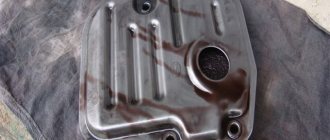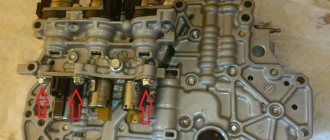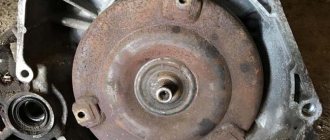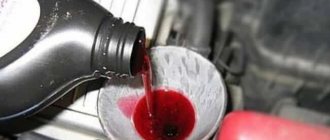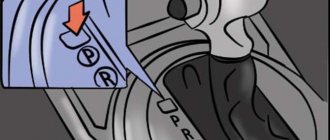When operating modern vehicles equipped with automatic transmissions, the transmission oil, as well as working units and parts of the automatic transmission, gradually become contaminated. Harmful sediments in the form of metal dust, shavings, fragments, combustion products and breakdown of friction clutches accumulate on working surfaces, filter screens, as well as in the cavities and channels of the hydraulic system. Flushing the automatic transmission is a necessary procedure to restore the stability of the transmission.
Why do you need to flush the automatic transmission?
During operation of the automatic transmission, the amount of mud deposits increases, which causes failure of both individual parts and the mechanism as a whole. Some car enthusiasts believe that they can get by with simply replacing the transmission oil and oil filter. However, as practice shows, in order to restore the stable functioning of an automatic transmission, simply replacing the lubricant is not always enough. To independently adjust the operation of the automatic transmission, washing the automatic transmission yourself is the best solution.
What is the essence of such an action as automatic transmission flushing? The answer is simple: an accessible way to clean the cavities of the gearbox from accumulated dirt is determined. The most commonly used method is flushing the machine’s channel system using lubricating fluid flows. Sometimes a special flushing agent or automatic transmission flushing fluid (Liqui Moly) is added to the transmission oil.
If this does not help, the gearbox is completely disassembled. After which, each part is cleaned manually using gasoline and compressed air.
Each of the described methods is successfully used in practice. The results of proper cleaning of the automatic transmission are noticeable in the following manifestations:
- The likelihood of automatic transmission breakdowns is reduced.
- The service life of the entire mechanism increases.
- The operation of the automatic transmission is corrected.
In order for flushing an automatic transmission to achieve maximum efficiency, it is necessary to perform each operation competently and accurately.
Complete automatic transmission cleaning
Often new car owners are interested in how to flush an automatic transmission at home. For a complete flush, you will need to disassemble the machine down to spare parts. If the car owner does not have certain skills, then it is recommended to use the washing method described above or take the car to a service station.
Read
Do-it-yourself oil change and automatic transmission repair U340E/U341E
Pallet
To start flushing, you need to drain all lubricant from the automatic transmission. And then start disassembling the machine.
The procedure is performed like this:
- The automatic transmission warms up by running the car. You can drive a vehicle for about 5 kilometers to warm up the machine to 70 degrees.
- Drive onto the overpass. Or it is best to lift the car on a lift. This is how the box and components will be dismantled.
- Unscrew the drain plug and place the container. Drain off all liquid.
- Unscrew the bolts of the box pan.
- Carefully remove it. Since there may be residual oil in it, drain it.
- Wash the pan with WD 40 liquid.
- Remove the magnets and clean them of metal shavings.
Remove the old filter device. Now you can start flushing the valve body.
Flushing the automatic transmission valve body
To wash the automatic transmission with your own hands, as experienced mechanics do, you need to dismantle the hydraulic plate.
Dismantling steps:
- After completing the first procedure, begin removing the valve body.
- Disconnect the connector and remove the adapter.
- Carefully remove the hydraulic plate from the machine so that no dirt or dust gets into it.
- Remove the electronic board and unscrew the bolts.
- Remove the top of the device.
- Unscrew the other plates. Carefully remove, not forgetting the springs.
- Remove the rods and place them on the table in the order in which they were removed.
- Use ABRO CARB Cleaner for cleaning.
- Replace all failed solenoids.
- Reassemble in reverse order.
Read
Automatic transmission repair on a Ford Explorer IV
Leave to dry on the table and move on to the filter device.
Washing the automatic transmission filter
Experts recommend replacing the box filter after 70,000 kilometers. However, if the car owner started flushing the automatic transmission before driving the required amount of kilometers, then he can wash the filter device and not install a new one. Use WD40 to wash the filter.
Flushing the automatic transmission torque converter
After the hydraulic unit has been removed, you need to completely dismantle the box. It should be noted that its weight starts from 65 kg. It all depends on the configuration. Therefore, it is advisable to carry out all work with a partner and having special lifts in the garage.
After the machine is removed, it is necessary to disassemble it.
- Remove and cut the donut.
- Check the turbine blades and pump wheel for deformation and wash them with Abro Cleaner liquid. Allow time to dry.
- Replace seals and seals.
- Carefully and tightly weld the seam connecting the two sides of the gas turbine engine.
After this, you can begin flushing the radiator, installing components back and changing the oil.
Flushing the transmission radiator
After all components have been washed and individual used automatic transmission parts have been replaced, you need to start cleaning the cooling system. It plays the main role and prevents the entire automatic transmission from overheating.
Many car owners recommend using kerosene to flush the radiator. But usually such a procedure is fraught with problems, which will be discussed in the next block.
To flush the radiator, you need to take a circular pump, oil and drive the lubricating fluid through the pipes of the cooling system.
After drying all the components, reassemble the automatic transmission in the reverse order and install it on the car. Fill with new oil. Drive ten kilometers and measure the level. If necessary, top up.
Read
Repair and replacement of automatic transmission donut
How often do you need to flush the automatic transmission?
During active use of the gearbox, it is recommended to flush the automatic transmission, in particular, to clean the valve body channels, simultaneously with a complete change of transmission oil (automatic transmission oil change with flushing). The service life of a vehicle transmission directly depends on the frequency of these activities. Flushing the automatic transmission when changing the oil means that the frequency of work is 30 - 70 thousand km of the distance traveled. The interval between automatic transmission maintenance activities is set depending on the operating conditions of the vehicle.
General characteristics
The hydrodynamic transformer is a hermetically sealed unit. It transmits torque from the drive to the box. Obviously: the torque converter replaces the clutch. Let's get acquainted with the principle of operation of the GT.
The drive crankshaft interacts with the pump wheel, whose task is to accelerate the mixture, then direct it to the turbine. The automatic transmission interacts with the turbine. The incoming liquid is pumped by a turbine and then returned to the pump. Before the pump, the mixture flows onto the reactor blades, whose task is to accelerate the flow of the mixture and direct it in the direction of rotation.
According to the specified cycle, the mixture is accelerated until the rotation speeds of the pump and turbine wheels are equal, after which the hydraulic transformer stops converting torque, and the reactor rotates freely, without interfering with the flow of liquid.
The difference in the rotation speeds of the pump and turbine wheels determines the acceleration of the working mixture, which, while rotating, begins to heat up, the efficiency of the hydrodynamic transformer decreases - a large amount of energy is spent on heating. When equalizing wheel speeds, there is no need to transmit torque using fluid due to large losses. Therefore, to the GT design, engineers decided to introduce a GD lock (elements whose operation is based on the action of friction), connecting the input and output shafts so that torque is transmitted directly. On modern cars, the locking is electronically controlled and controlled by a separate valve. There are many locking designs, but they have the same meaning - connecting shafts to temporarily exclude the transmission mixture from the torque transmission chain.
The operation of the torque converter is monitored using a special control unit, which is an automated system that receives data from sensors located on the hydraulic transformer and automatic transmission. When a malfunction is detected in the operation of these units, the electronics signals an error. On some car models, the operation of the torque converter can be completely blocked - this leads to the engine turning off when there are changes in the operation of the automatic transmission. Many GT failures occur on the part of mechanical elements, so when carrying out diagnostics it is difficult to determine the location of the malfunction; you need to disassemble the damaged unit and perform a visual inspection to understand why the GT stopped working.
We recommend watching a video about repairing a GT automatic transmission:
What you need to prepare for washing the automatic transmission
This event is best carried out in specialized workshops. Most service companies are equipped with special washing devices, with the help of which the unit is washed at the proper professional level. If during diagnostics it turns out that it is necessary to disassemble the automatic transmission and change some parts and components, the box is rebuilt, all its elements are washed in gasoline, and the channels are purged with compressed air.
If you decide to flush the automatic transmission yourself, you need to create the conditions and acquire consumables, auxiliary tools, and accessories:
- Transmission fluid in double volume (the first portion of ATP oil will be used for flushing the unit, the second - for refueling, respectively).
- Adjustable wrenches, sockets, polygons, gasoline, screwdrivers, pump.
- Bucket or basin for waste material.
- Cotton rags.
- Observation deck, overpass.
The design and principle of operation of the torque converter
The idea of automatic gear shifting in cars with manual transmissions appeared immediately after their introduction, at the beginning of the 20th century. The first automatic transmissions were created in the same years and operated on the basis of servos, which, by the way, were not particularly convenient for automating the process of changing gears. They were replaced by hydraulic devices called fluid couplings.
The first such mechanism appeared in 1902 and 5 years later it was installed in the design of a high-speed vessel. Later, namely in 1928, the fluid coupling was successfully built into the transmission of a bus, and then into a car. General Motors and Chrysler companies, from 1945 to 1980, qualitatively improved the design of the fluid coupling, which provoked the emergence of a unit with a new name - the torque converter. It was this mechanism that began to be equipped with all automatic transmissions produced, and engineers worked only to improve it.
The torque converter of an automatic transmission is an analogue of the clutch of a manual transmission, which operates in automatic mode. Today, this hydromechanical device performs three main functions:
- The first one transmits rotation from the engine shaft to the automatic transmission mechanism;
- The second one softens the transmission of rotation to the level in which the gearbox is able to accept it without problems (that is, the torque converter protects the machine during sharp decreases and increases in the speed of the running engine);
- And the third - normalizes the supply of rotational motion to the box during acceleration (this is necessary in order to “dampen” the double increase in rotation transmitted from the motor to subsequent shafts).
Modern automatic transmission torque converters may be considered separate units from the planetary gearset (box), but they will not be able to work independently without it. This is due to the fact that this mechanism and the automatic transmission valve body (hydraulic plate) are inextricably linked. Their connection, by the way, is very simple - the second transmits the required amount of transmission fluid to the first, without which the operation of the torque converter is simply impossible.
The design of the device is also not particularly complicated and is a mill, some of the blades of which rotate due to the connection with the engine, and the others regulate the rotation using the hydraulic oil pressure available in the mechanism. The operation of the torque converter is important for the box only at vehicle speeds of up to 60-80 km/h, therefore, when this speed is reached, all the blades of the mechanism are locked into a single unit, after which rotation is transmitted directly to the box. Note that it is in locking the torque converter that the automatic transmission valve body plays an important role, therefore the functioning of these elements of the machine cannot be separated.
Washing the automatic transmission without removing it from the machine
This procedure is carried out using a special device. Standard list of work carried out by service station employees:
- First, the used old oil is drained. In order for the maximum amount of used fluid to flow out, the automatic transmission pan is removed and the drain plug is unscrewed.
- After draining the liquid, all parts are installed in their original places.
- A device filled with new transmission oil is connected.
- The engine starts.
- The motor runs for at least 15 minutes.
- At this time, oil under pressure passes through all channels of the automatic transmission hydraulic system.
- The ATF oil from the automatic transmission is drained again.
- The worn oil filter is removed and a new filter element is installed in its place.
- The automatic transmission pan gasket is being replaced.
- Fresh transmission oil is added.
Full flow cleaning
This method includes cleaning the automatic transmission along with changing the oil. First, the waste is drained and the filter is replaced. The next step is to flush the box and fill in new lubricant.
Washing the automation is carried out on a lift or inspection pit, since in this situation it is necessary to remove the pan to allow residual fluid to leak out and replace the oil filter. At service stations they use a washing unit. It contains pipes that are connected to the automatic transmission cooling system.
After this, the engine is started and left to run for 20 minutes. At the end of this operation, the flushing liquid flows into the pan. Then it is carefully unscrewed and the waste is drained. In this case, solid metal residues and slags flow out thanks to the flushing liquid.
Next, replace the pan gasket and filter. Using the automatic transmission oil filler line, new car oil is filled to a specific mark. The flushing unit connected to the cooling system is left in its current position.
The motor starts, and the lubricant is circulated through the box several times, and then drains through the installed flushing equipment hose.
The procedure ends after the amount of oil poured is compared with the volume of oil flowing out. When washing the box, it is recommended to switch speeds to modes D, R and vice versa, to completely wash the gears and parts.
This method is used only in the warm season, since the operating temperature of the flushing liquid is -10°C for the automation system.
Features of complicated box cleaning
If the gearbox is removed from the car for subsequent repairs, it is recommended to wash the automatic transmission cavities not in the standard way, but using more complex manipulations. Procedure:
- Drain the oil from the box.
- Remove the automatic transmission from the vehicle.
- Completely disassemble the mechanism.
- Thoroughly rinse each element in gasoline (diesel oil, kerosene).
- Blowing the valve body channels with compressed air.
- Replacement of consumable spare parts (filter elements, gaskets, seals, seals, etc.).
- Reassembling the automatic transmission to its original condition.
- Installing an automatic transmission on a car.
- Filling the system with ATF transmission fluid.
- Running in the automatic transmission.
Important: When breaking in a vehicle, you must adhere to gentle conditions, avoid sudden maneuvers, sharp turns, emergency braking and other increased loads. The automatic transmission adaptation process lasts several days (from 4 to 7).
Automatic transmission cleaning methods
Proper automatic transmission maintenance involves cleaning the existing cavities of the box from accumulated dirt. A similar procedure is performed by passing a small amount of oil through the system and then draining it. Ideally, the car owner should dismantle the valve body, open it, manually clean all internal elements, wash the automatic transmission filter, then blow it with air, wipe it with gasoline, run oil through the system, and only then reassemble the box in the reverse order.
In rare cases, to clean automatic transmissions, special auto chemicals and flushing additives are added to old oil, which, while in the lubricant, soften deposits, quickly removing dirt.
All that remains for the car owner to do is to perform a timely oil change.
This method of washing an automatic transmission can be used to prevent serious contamination. If the transmission is already difficult to shift into upshifts and downshifts, you need to open it and clean it manually.
Automatic transmission radiator flushing
There are many discussions devoted to this topic among experienced motorists. Some reputable drivers recommend regularly cleaning the automatic transmission cooling circuit tubes. According to others, this device should be replaced with a new copy. In any case, each car owner will make his own decision. The design of the radiator is a complex system. If the conductivity of the lines is poor, the heat exchange of the transmission oil in the hydraulic system of the automatic transmission is disrupted.
Major breakdowns
Signs that require automatic transmission torque converter repair:
- There is a slight mechanical sound when shifting gears, which disappears as the revs increase. The GT support bearings may be broken; the unit needs to be disassembled to assess its condition.
- At a speed range of 60 - 90 km/h, a slight vibration of the box is felt. The transmission mixture may need to be replaced; contaminated fluid is clogging the oil filter. The malfunction is eliminated by replacing the oil filter and the GT consumable mixture. At the same time, the lubricant in the engine and gearbox is replaced.
- Problems arise with the dynamics of the car - this is a symptom of a faulty overrunning clutch. It is necessary to open the GT and replace the damaged coupling.
- The car has stopped and there is no way to continue driving. The turbine wheel or its splines need to be replaced.
- When the car is started, a characteristic noise is heard. The bearing located between the turbine or reactor wheel and the GT cover may be broken. The cost of repair work in such a situation is not very high, but requires timely contact with a service station.
- When changing gears, a loud metallic sound can be heard. It is necessary to check the torque converter blades. Repair involves replacing a worn wheel.
- The appearance of aluminum powder in the oil taken from the automatic transmission dipstick indicates wear on the end washer; you should also check the freewheel.
- An unpleasant smell of melting plastic appears in the area of the automatic transmission - overheating of the torque converter. Causes of failure: drop in transmission mixture level, malfunction of the transmission cooling system. The problem will be resolved by replacing the lubricant and checking the functionality of the cooling system.
- The drive stalls when changing gears. The torque converter control unit may have failed.
It is possible to specifically indicate why the torque converter broke after opening it. But there are malfunctions that can be eliminated by replacing the lubricant; they are indicated by the corresponding signs of breakdowns.
Flushing the automatic transmission torque converter
This procedure is carried out only after cutting the “donut”. After opening the case, all parts and components of the mechanism are carefully inspected and analyzed to eliminate breakdowns and defects.
The following elements of the automatic transmission torque converter are checked and cleaned:
- Turbine blades.
- O-rings.
- Oil seals.
- Clutch elements.
After cleaning the internal parts, the torque converter housing is carefully welded. Basic requirements for the weld: ensuring tightness and restoring the aesthetic appearance of the assembled product.
Removing/installing, cutting, washing, welding the torque converter housing - all these operations can only be done by experienced service center specialists. It is not recommended to do this work yourself without the necessary skills at home.

